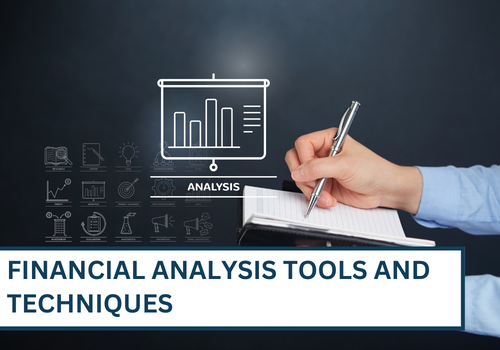Financial Analysis Tools and Techniques: Optimizing Your Financial Decision-Making
Financial analysis is a critical process that helps individuals and businesses assess their financial health, make informed decisions, and achieve their goals. In today’s fast-paced and complex financial landscape, having access to reliable and efficient financial analysis tools and techniques is essential. This article will delve into the world of financial analysis, exploring a range of tools and techniques that can empower you to optimize your financial decision-making.
Introduction
Financial analysis involves the examination of financial statements, data, and other relevant information to assess an entity’s financial performance and potential. It provides valuable insights into areas such as profitability, liquidity, solvency, efficiency, and growth. By using appropriate financial analysis tools and techniques, individuals and businesses can gain a deeper understanding of their financial position and make well-informed decisions to enhance their financial outcomes.
Importance of Financial Analysis
Accurate financial analysis is crucial for several reasons. Firstly, it enables businesses to evaluate their financial viability, identify areas of improvement, and develop effective strategies for growth. Secondly, individuals can utilize financial analysis to assess their personal financial situation, manage debt, plan for retirement, and achieve their financial goals. Lastly, investors and stakeholders rely on financial analysis to make informed decisions about investing, lending, or partnering with an organization.
Ratio Analysis
Ratio analysis is a fundamental tool in financial analysis that involves the calculation and interpretation of various financial ratios. These ratios provide insights into an entity’s financial performance, stability, and efficiency. Some common types of ratios used in financial analysis include liquidity ratios, profitability ratios, efficiency ratios, and debt ratios.
- Liquidity Ratios
Liquidity ratios measure an organization’s ability to meet its short-term obligations. Examples of liquidity ratios include the current ratio, quick ratio, and cash ratio. These ratios assess the availability of liquid assets to cover immediate liabilities and determine the entity’s short-term financial health. - Profitability Ratios
Profitability ratios evaluate the entity’s ability to generate profits from its operations. Gross profit margin, net profit margin, return on assets (ROA), and return on equity (ROE) are commonly used profitability ratios. These ratios help assess the efficiency and effectiveness of the organization in generating profits and maximizing shareholder value. - Efficiency Ratios
Efficiency ratios analyze how effectively an organization utilizes its assets and resources to generate revenue. Examples include inventory turnover ratio, accounts receivable turnover ratio, and asset turnover ratio. Efficiency ratios highlight the entity’s operational effectiveness and efficiency in managing its resources. - Debt Ratios
Debt ratios measure the level of debt an entity has in relation to its assets, equity, or earnings. Debt-to-equity ratio, debt ratio, and interest coverage ratio are commonly employed debt ratios. These ratios provide insights into the organization’s leverage, solvency, and ability to repay its debt obligations.
Trend Analysis
Trend analysis involves analyzing financial data over a specific period to identify patterns and trends. It enables individuals and businesses to assess their financial performance over time, identify areas of improvement, and make strategic decisions accordingly. By examining trends in key financial metrics, such as revenue, expenses, and profitability, stakeholders can gain a comprehensive view of the organization’s financial trajectory. this is best Financial Analysis Tools and Techniques
Cash Flow Analysis
Cash flow analysis focuses on understanding the inflow and outflow of cash within an entity. It helps assess the organization’s ability to generate sufficient cash to meet its operating, investing, and financing needs. By examining cash flow patterns, individuals and businesses can identify potential cash shortages, plan for contingencies, and optimize their cash management strategies.
Break-Even Analysis
Break-even analysis is a powerful technique that helps determine the point at which revenue equals expenses, resulting in neither profit nor loss. It enables businesses to assess the minimum level of sales needed to cover costs and provides insights into pricing strategies, cost structures, and profit potential. By conducting a break-even analysis, entrepreneurs can make informed decisions regarding pricing, production volume, and profitability.
Scenario Analysis
Scenario analysis involves assessing the potential impact of various scenarios on an organization’s financial performance. By considering different possible outcomes and their associated probabilities, individuals and businesses can develop robust contingency plans and evaluate the potential risks and rewards of different strategies. this is a latest Financial Analysis Tools and Techniques.
SWOT Analysis
SWOT (Strengths, Weaknesses, Opportunities, Threats) analysis is a strategic framework that helps evaluate the internal and external factors influencing an organization’s performance. By identifying strengths, weaknesses, opportunities, and threats, stakeholders can make informed decisions, capitalize on their advantages, address weaknesses, seize opportunities, and mitigate threats effectively.
Sensitivity Analysis
Sensitivity analysis involves examining how changes in certain variables impact an organization’s financial outcomes. By assessing the sensitivity of key metrics to changes in factors like sales volume, costs, or interest rates, decision-makers can identify potential risks, assess their impact, and develop risk mitigation strategies. these points comes into Financial Analysis Tools and Techniques.
Monte Carlo Simulation
Monte Carlo simulation is a statistical technique that helps assess the impact of uncertainty on an organization’s financial performance. By running multiple simulations based on different scenarios and probability distributions, decision-makers can gain insights into the range of potential outcomes, assess risks, and make more informed decisions.
Decision Trees
Decision trees are graphical representations of decision-making processes that help analyze the potential outcomes of different choices. By mapping out various alternatives and their associated probabilities, decision-makers can visualize the potential consequences of different decisions and select the optimal course of action.
Risk Assessment Tools
Risk assessment tools help individuals and businesses identify, analyze, and manage risks effectively. These tools include risk matrices, risk registers, and risk heat maps. By systematically assessing risks and their potential impacts, stakeholders can develop risk mitigation strategies and enhance their decision-making processes.
Capital Budgeting Techniques
under the Financial Analysis Tools and Techniques. we should read about Capital budgeting techniques assist organizations in evaluating and selecting investment projects. Techniques like net present value (NPV), internal rate of return (IRR), and payback period enable decision-makers to assess the profitability and feasibility of potential investments. By utilizing these techniques, organizations can allocate their capital resources effectively and maximize returns.
Financial Modeling
Financial modeling involves creating mathematical representations of financial scenarios to assess potential outcomes and make informed decisions. It helps individuals and businesses forecast future financial performance, evaluate the impact of different variables, and simulate different scenarios. Financial models can range from simple spreadsheets to complex software applications.








